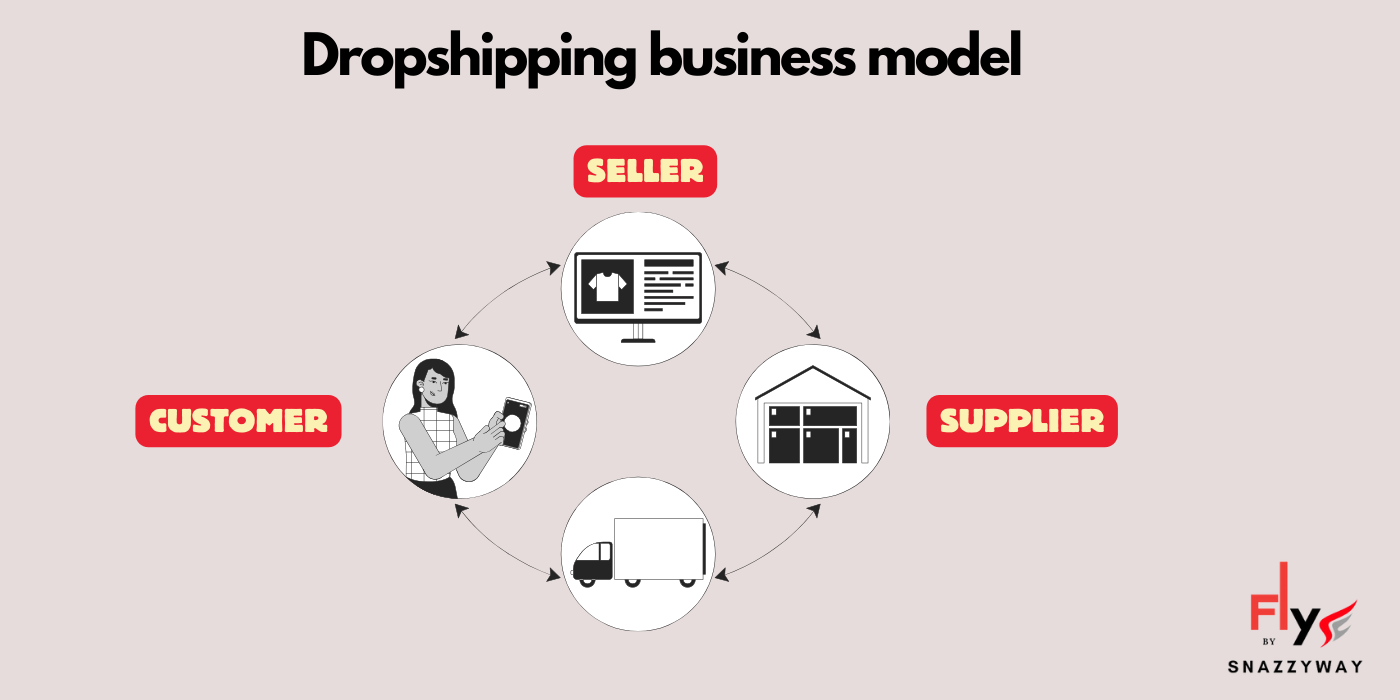
How to Start a Dropshipping Business in India: Tips, Tools, and Strategies for 2026
Dropshipping is a dynamic way to sell products online without the headache of holding any inventory. Instead of stocking goods, the retailer (you) passes customer orders and delivery details to a supplier, who then ships the products directly to the customer. This method is incredibly popular, especially in India, because it offers low startup costs, low risk, and allows you to sell a vast array of products.
If you’re curious about dropshipping in India, this article will guide you through starting your business in ten simple, actionable steps. We’ll walk you through selecting a profitable niche, building your brand, creating an online store, and successfully promoting your products.
What is Dropshipping ?
In dropshipping, the retailer acts as a middleman between the customer and the supplier. The retailer promotes the products, sets the prices, and runs the online store, while the supplier takes care of the inventory and shipping. This setup is great because it requires little initial investment.

An Example to Illustrate the Dropshipping Flow:
Customer Places an Order: A customer visits your website and orders an item for ₹1,500.
Processing the Order: You receive the order and payment. You then place an order with your dropshipping supplier for the same item, paying the wholesale price (e.g., ₹900).
Supplier Ships the Product: The supplier processes the order and ships the item directly to the customer, using your store’s branding details.
Profit: You realize a profit of ₹600 (₹1,500 retail – ₹900 wholesale), minus transaction fees and marketing costs.
🔟 Steps on How to Start a Dropshipping Business in India
📊 Table 1 — Dropshipping Startup Checklist (Step-by-Step)
| Step | Action | Why It Matters |
|---|---|---|
| 1 | Choose a niche | Targets audience & reduces competition |
| 2 | Market research | Finds demand & pricing insights |
| 3 | Select platform | Builds your store (Shopify/WooCommerce) |
| 4 | Find suppliers | Ensures quality & delivery reliability |
| 5 | Set up payments | Enables customer purchases securely |
| 6 | Design product pages | Improves conversions & trust |
| 7 | Launch marketing | Drives traffic and first sales |
| 8 | Test & optimize | Refines ads, pricing & customer flow |
Starting a dropshipping business can be a fast, effective way to enter the world of e-commerce with relatively low upfront costs. Here are ten steps tailored for the Indian market:
Choose a Profitable Niche: Identify your target market and focus on high-demand, low-competition products.
Find Reliable Dropshipping Suppliers in India: Partner with suppliers known for product quality and fast fulfillment.
Create a Business Plan: Outline your goals, target audience, marketing strategy, and financial projections.
Choose an E-commerce Platform: Select a reliable platform like Shopify or WooCommerce for easy management.
Register Your Business & Get GST: Crucial step for legal and payment compliance in India.
Set Up Payment Gateways: Integrate India-friendly options like Razorpay, PhonePe, and major credit cards.
Add Products to Your Store: Import product listings with high-quality images and compelling descriptions.
Market Your Store: Utilize SEO, social media marketing, and paid ads to drive targeted Indian traffic.
Optimize for Conversions: Improve user experience and simplify the checkout process to increase sales.
Manage Orders Efficiently: Automate order processing and fulfillment through reliable software.
1- Choose a Dropshipping Niche

With nearly 34% of online retailers using dropshipping, the industry is competitive. Distinguishing your brand is vital. Focusing on a specific, unique niche is the most effective way to attract a loyal customer base, such as specializing in products for outdoor enthusiasts or sustainable fashion.
Key Pointers for Selecting the Ideal Niche:
Identify Your Interests and Passions: A genuine interest helps you stay motivated.
Evaluate Market Demand: Use tools like Google Trends to check the popularity of your potential niche over time.
Analyze Competition: Assess competitor strengths/weaknesses and determine how you can differentiate your offering.
Consider Profitability: Ensure there is a strong margin between the wholesale and retail prices after factoring in all costs.
Target Audience: Define your ideal customer’s demographic and pain points that your products can solve.
2. Find Reliable Dropshipping Suppliers

Reliable dropshipping suppliers are the backbone of your business, directly impacting product quality and fulfillment speed. For a successful operation in India, focus on partners who understand the local logistics landscape.
Key Factors for Supplier Selection:
Experience and Stability: Look for long-established suppliers with a proven track record.
Integration Capabilities: Verify compatibility with your e-commerce platform (e.g., Shopify, WooCommerce) for seamless inventory and order management.
Product Quality: Always request samples to evaluate quality firsthand before committing.
Customer Support and Communication: Choose suppliers who are responsive to resolve issues quickly and efficiently.
3- Create a Business Plan

A well-structured business plan is your roadmap to growth. It outlines your strategy, goals, and operational approach.
Key Components of Your Dropshipping Business Plan:
Executive Summary: Summarize your business, target market, and Unique Selling Proposition (USP).
Market Research: Detailed analysis of the e-commerce industry, your target audience, and competitor strengths.
Business Model: Details on your niche, product range, pricing strategy, and expected profit margins.
Marketing and Sales Strategy: Outline tactics, including SEO, social media marketing, and paid advertising efforts.
Financial Plan: List startup costs, revenue projections, and operating budget.
4- Choose an E-commerce Platform

Choosing the right e-commerce platform is a crucial decision for your dropshipping business. The platform you select will influence the functionality, design, and overall efficiency of your online store. Here’s a guide to help you choose the best e-commerce platform for your needs:
📊 Table 2 — Essential Dropshipping Tools & Their Uses
| Tool Type | Example Tools | Purpose |
|---|---|---|
| E-Commerce Platform | Shopify, WooCommerce | Build & manage your store |
| Product Research | Jungle Scout, Sell The Trend | Find winning products |
| Order Automation | Oberlo, DSers | Sync orders with suppliers |
| Analytics | Google Analytics, Hotjar | Track performance & behavior |
| Marketing | Facebook Ads, Klaviyo | Attract & retain customers |
| Customer Support | Zendesk, Tidio | Provide support & increase conversions |
1. Determine Your Requirements
- Business Size: Consider the scale of your business, including the number of products and anticipated traffic. Ensure the platform can handle your needs both now and as you grow.
- Features Needed: Identify essential features such as product management, payment processing, order fulfillment, and customer support.
2. Evaluate Platform Options
- Shopify: Known for its user-friendly interface and robust dropshipping integrations. Ideal for businesses of all sizes with a range of customizable themes and apps.
- WooCommerce: A WordPress plugin offering flexibility and control over your online store. Best for users familiar with WordPress and those seeking customization.
- BigCommerce: Offers advanced features and scalability with strong built-in tools for SEO, marketing, and analytics.
- Wix eCommerce: Provides a simple, drag-and-drop interface with a range of design options. Suitable for small to medium-sized businesses looking for ease of use.
- Magento: A powerful, open-source platform offering extensive customization and scalability. Best for larger businesses with specific needs and technical expertise.
3. Consider Cost and Pricing Models
- Initial Costs: Assess the upfront costs associated with each platform, including setup fees and theme purchases.
- Monthly Fees: Compare the ongoing subscription fees and whether they fit within your budget.
- Transaction Fees: Check if the platform charges transaction fees on sales and compare these costs across options.
4. Integration Capabilities
- Dropshipping Integrations: Ensure the platform supports integration with popular dropshipping tools and suppliers, such as Oberlo, AliExpress, or Printful.
- Third-Party Tools: Evaluate the platform’s ability to integrate with other tools and services you might need, such as CRM systems, email marketing platforms, and analytics tools.
5. Design and Customization
- Templates and Themes: Look for a platform offering a variety of professionally designed templates and themes that align with your brand.
- Customization Options: Ensure you can customize the design to fit your brand’s unique look and feel, including layout, colors, and fonts.
6. Ease of Use
- User Interface: Choose a platform with an intuitive and user-friendly interface, especially if you have limited technical skills.
- Setup and Management: Consider how easy it is to set up and manage your store, including product uploads, order management, and customer interactions.
Choosing the right e-commerce platform is key to running a successful dropshipping business. By evaluating your needs and comparing different options, you can select a platform that supports your business goals and provides a seamless shopping experience for your customers.
5- Register Your Business

Registering for GST in India involves a series of steps to ensure compliance with the Goods and Services Tax regulations. Here’s a detailed guide to help you through the process:
1. Determine Eligibility for GST Registration
- Turnover Threshold: If your aggregate turnover exceeds ₹40 lakhs (₹20 lakhs for special category states) in a financial year, you must register for GST.
- Voluntary Registration: You may opt for voluntary registration even if your turnover is below the threshold to avail of input tax credits and enhance your business credibility.
2. Gather Required Documents
- PAN Card: A copy of your Permanent Account Number (PAN) card.
- Aadhaar Card: The Aadhaar number of the business owner or authorized signatory.
- Business Address Proof: Rent agreement, utility bills, or property documents for the business location.
- Identity Proof: PAN card, passport, voter ID, or driver’s license of the business owner or authorized signatory.
- Bank Account Statement: A copy of a recent bank statement or a canceled cheque showing the business account.
3. Visit the GST Portal
- Website: Go to the official GST portal gst.gov.in.
- Sign Up: Click on “Services” and select “Registration” followed by “New Registration.”
4. Fill Out the GST Registration Application
Part A: Basic Information
- Legal Name: Enter the legal name of the business as per the PAN card.
- Business Structure: Select the type of business entity (e.g., sole proprietorship, partnership, LLP, company).
- State and District: Specify the state and district where your business is located.
Part B: Detailed Information
- Business Details: Provide details about the business, including the nature of goods or services, business activities, and turnover.
- Owner/Authorized Signatory Details: Enter details of the owner or authorized signatory, including PAN, Aadhaar, and contact information.
5. Submit Application and Documents
- Upload Documents: Upload the required documents as specified in the application form.
- Verification: After submission, the application will be verified by the GST authorities. You may receive a request for additional information or documents if necessary.
6. Receive GSTIN
- GST Identification Number (GSTIN): Upon successful verification, you will receive a GSTIN and a GST registration certificate. This number must be used on all invoices and tax documents.
Here are several important reasons why obtaining a GST number is essential for your business IN India:
Accept Payments: To process payments through your web store, you need a GST number. All major payment gateways, whether domestic or international, require GST registration to facilitate transactions.
Sell on Marketplaces: Platforms like Amazon and Flipkart mandate a GST number for sellers. Without it, you won’t be able to list and sell your products on these popular e-commerce sites.
Run Advertisements: A GST number is necessary to run Facebook ads for your business. It ensures that your advertising campaigns are compliant with tax regulations and properly managed.
Contract with Shipping Companies: If you want to work with shipping companies, a GST number is required. It helps in processing shipments and handling logistics smoothly.
6- Set Up Payment Gateways

Setting up payment gateways is a crucial step for ensuring that your dropshipping business can process transactions smoothly and securely. Payment gateways facilitate online payments, enabling customers to pay for their purchases using various methods.
Setting up payment gateways involves selecting the right ones for your business, such as Razorpay or Phonpe, and registering an account with them. Integrate the gateway with your e-commerce platform, ensuring it supports various payment methods and currencies. Configure security settings, including PCI compliance and SSL certificates, to protect customer data. Test the integration thoroughly, set up notifications for transactions, and monitor the system regularly to ensure smooth payment processing and address any issues promptly.
7- Add Products to Your Store

To add products from your suppliers to your store, start by selecting a reputable supplier and obtaining their product catalog or data feed. Review the catalog to ensure the products meet your quality standards and fit your niche. Next, upload the product details to your e-commerce platform, including comprehensive descriptions, accurate pricing, and high-quality images. Make sure to format and present the information in a way that aligns with your store’s branding and appeals to your target customers.
Organize the products into relevant categories to facilitate easy navigation and enhance the shopping experience. Regularly update your store with any new products or changes in existing product details from your supplier. Ensure that your inventory is synchronized with the supplier’s stock levels to avoid discrepancies and manage orders efficiently. This approach will help maintain accurate product listings and ensure a smooth and professional shopping experience for your customers.
8- Market Your Store

Marketing your store is essential for attracting customers and driving sales. Begin by identifying your target audience to tailor your marketing strategies effectively. Build a strong online presence by creating engaging content and maintaining active social media profiles that resonate with your audience. Leverage email marketing to keep potential and existing customers informed about promotions, new products, and updates.
Optimize your store for search engines using SEO techniques to increase visibility and drive organic traffic. Consider using pay-per-click (PPC) advertising and social media ads to reach a broader audience and drive targeted traffic to your site. Engage with your audience through compelling content, special offers, and interactive promotions to foster a connection and encourage repeat business.
Utilize analytics tools to track the performance of your marketing efforts, understand customer behavior, and measure the effectiveness of your campaigns. Regularly review these metrics to refine your strategies and ensure that your marketing activities are aligned with your business goals. Continuously adapting and optimizing your marketing approach will help you stay competitive and grow your customer base effectively.
9- Optimize for Conversions

Optimizing for conversions involves refining your website and marketing strategies to maximize the percentage of visitors who take desired actions, such as making a purchase or signing up for a newsletter. Start by analyzing user behavior through tools like Google Analytics to identify areas where visitors drop off or experience friction.
Enhance your website’s user experience by ensuring that it is fast, mobile-friendly, and easy to navigate. Simplify the checkout process to reduce cart abandonment by minimizing the number of steps and offering multiple payment options. Use high-quality images, compelling product descriptions, and clear calls to action to make it easier for customers to make decisions.
Implement A/B testing to experiment with different elements of your site, such as headlines, buttons, and layouts, to determine what works best for your audience. Collect and analyze customer feedback to address any issues and make data-driven improvements. Continuously monitor and adjust your strategies to ensure that your site is effectively converting visitors into customers.
10- Manage Orders

Managing orders involves overseeing the entire process from when a customer places an order to its delivery. Start by setting up a system to track and process incoming orders efficiently. Ensure that your order management system is integrated with your e-commerce platform and payment gateways to automatically update order statuses and inventory levels.
Verify order details and confirm payment before processing. Coordinate with suppliers to ensure timely fulfillment and accurate shipping. Keep customers informed by providing order confirmations, tracking information, and updates on any changes or delays.
Handle returns and exchanges promptly by establishing clear policies and procedures. Monitor order fulfillment performance to identify any issues or bottlenecks and continuously refine your processes to improve efficiency and customer satisfaction. Regularly review and adjust your inventory levels to prevent stockouts or overstock situations, ensuring smooth order management and reliable service.
What to Avoid When Starting a Dropshipping Business?
When starting a dropshipping business, it’s important to avoid common pitfalls that can hinder your success. Here are key things to watch out for:
Choosing the Wrong Niche: Avoid selecting a niche solely based on trends or popularity without considering long-term demand and your own interests. A well-researched niche with consistent demand and manageable competition is crucial.
Ignoring Supplier Reliability: Partnering with unreliable suppliers can lead to poor product quality, delays, and customer dissatisfaction. Vet suppliers thoroughly and maintain good communication to ensure they can meet your business needs.
Neglecting Market Research: Failing to understand your target market and competitors can result in ineffective marketing and product offerings. Conduct comprehensive market research to identify customer preferences and industry trends.
Overlooking Profit Margins: Be cautious of products with low profit margins, as they may not cover your costs or generate sufficient profit. Calculate all expenses, including product cost, shipping, and marketing, to ensure a sustainable business model.
Skipping Legal and Tax Compliance: Avoid ignoring legal requirements such as business registration, tax obligations, and obtaining necessary permits. Compliance helps protect your business and ensures smooth operations.
Inadequate Marketing Strategy: Relying solely on organic traffic without a solid marketing plan can limit your store’s visibility. Invest in a well-rounded marketing strategy that includes social media, SEO, and paid advertising.
Conclusion
Starting a dropshipping business offers an exciting opportunity to enter the e-commerce world with relatively low upfront investment. To build a successful dropshipping venture, begin by carefully selecting a niche that aligns with your interests and market demand. Conduct thorough research to find reliable suppliers and choose an e-commerce platform that suits your needs. Develop a comprehensive business plan and register your business to ensure compliance with legal and tax requirements, including obtaining a GST number if applicable.
Setting up payment gateways is essential for processing transactions smoothly, and integrating products from your suppliers should be done meticulously to ensure accurate listings and inventory management. Effective marketing strategies are crucial to driving traffic and converting visitors into customers, while optimizing your website for conversions will enhance the user experience and increase sales.
Managing orders efficiently and providing excellent customer service are key to maintaining customer satisfaction and building a positive reputation. By avoiding common pitfalls, such as choosing the wrong niche or neglecting supplier reliability, you can create a solid foundation for your dropshipping business and position yourself for long-term success. With careful planning, strategic execution, and ongoing optimization, you can turn your dropshipping venture into a thriving and profitable enterprise.
Start your dropshipping business in India with snazzyway !
Kickstart your dropshipping business in India with Snazzyway and unlock the potential for success. Our platform provides you with a curated selection of high-quality products and seamless integration tools to get you started quickly. Benefit from our expert support and proven strategies designed to maximize your sales and streamline your operations. Join the growing network of successful entrepreneurs leveraging Snazzyway’s innovative solutions. Start today and watch your dropshipping business thrive!
Dropshipping is a business model where you sell products online without holding inventory. When a customer orders, the supplier ships the product directly to the buyer, and you keep the profit margin..
Yes. Dropshipping is profitable in 2026 with the right niche, reliable suppliers, proper pricing, and effective marketing. Success depends on demand, margins, and customer acquisition costs..
No. Beginners can start dropshipping without business registration. However, registering improves trust, payment access, supplier partnerships, and long-term scalability.
Shopify and WooCommerce are the most popular platforms for beginners due to ease of use, integrations, and scalability. Marketplaces require higher compliance.
Most searched on Snazzyway Dropshipping – Babydoll lingerie dropshipping | Designer lingerie dropshipping | Free dropshipping websites | Snazzyway fly | Dropship women’s nightwear | Sell on Amazon | Dropship cosmatics |Private label lingerie |White label dropshipping | Shopify dropshipping suppliers |
